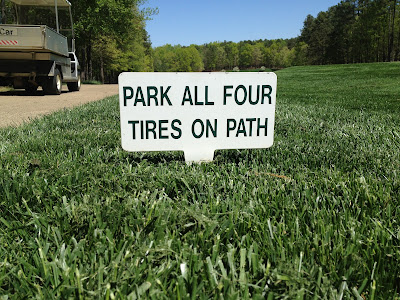Cart Traffic Reminders
Thank you for your patience and cooperation this winter. Ground conditions are improving daily and soon we will unleash the carts. We plan to hold off for at least one more week to allow some of the new seed in the rough to reach mowing height and to hopefully complete winter weed control in the zoysia. When the big day arrives, it's important that everyone follow these "rules" :
- No more than TWO CARTS per group may leave the path on any given hole. Foursomes with four carts should keep at least two carts on the path.
- WHITE TOP POSTS...Exit the path beyond the first post you see once you've reached a point on the path adjacent to your ball. Return to the path before passing the second post. The posts DO NOT identify the exact location where you must come and go. In fact it's better if you do not do that. They are just guides to help you follow the 90 Degree Rule. Maximize time on the path and minimize time on the turf.
- ROUGH...stay out of the rough at all times unless you're getting to the fairway or back to the path.
- PAR 3s are Cart Path Only all the time
- PARK all 4 tires on the path when stopped at tees and greens.
- BE ALERT to signs on certain holes where carts may be restricted to paths.
For the most part, we are just too wet to allow traffic in the winter, but there are times when we dry out between rains. In these times it can be tough not to cave to the pressure to let carts leave the path.
Having the patience and discipline to do what's best for the turf will pay off in the long run. Contrary to what many may think, we are actually very liberal in our approach to winter traffic. Experts say it's best to eliminate traffic in dormant turf. In my prior role, at a very upscale club in Atlanta with zoysia fairways, we were cart path only from the first frost in the fall until at least April 1. That was widely accepted and appreciated by members as the way to have perfect fairways in peak season. My first hand experience is that fairways are much better without winter traffic. That is true for the roughs as well. Our recovery efforts from summer traffic in the roughs costs $10-15K in the fall. Those areas will fare much better if we give them some time to recover.
From USGA Green Section:
click here for the full article
Below are some of the risks and side effects of winter cart traffic on zoysiagrass fairways. These may largely be applied to bermudagrass as well.
- Slow spring greenup – Zoysiagrass exhibits excellent wear tolerance, but not when it is dormant and unable to recover through growth. As such, the effects of winter traffic accumulate, and this results in a less-than-durable stand of turf that is very slow to green-up in the spring.
- Soil compaction – Oftentimes soils are not completely frozen during winter play, and wet soils are easily compacted. Root systems are sacrificed and poor turf health follows. Additional aeration is needed on fairways that receive winter cart traffic.
- Weed contamination – Thin areas or wear patterns often develop in high traffic areas and voids in the zoysiagrass are quickly established with winter weeds or resident bermudagrass populations. Winter weeds are fairly easy to control, but bermudagrass contamination in zoysiagrass can be a major, if not expensive, problem.
- Large patch (zoysia patch) – Damage from this turfgrass disease often lingers for weeks and months where zoysiagrass, weakened and stunted from winter cart traffic, is very slow to recover and unable to grow given the damage.
- Weakened turf - The biggest pitfalls of winter cart traffic are the season-long weakened state of zoysiagrass and the increased potential for future turf loss.
 |








Comments
Post a Comment